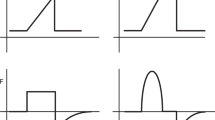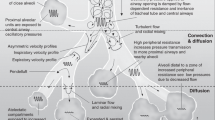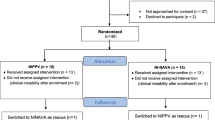Abstract
Remarkable technological advances over the past two decades have brought dramatic changes to the neonatal intensive care unit. Microprocessor-based mechanical ventilation has replaced time-cycled, pressure-limited, intermittent mandatory ventilation with almost limitless options for the management of respiratory failure in the prematurely born infant. Unfortunately, much of the infusion of technology occurred before the establishment of a convincing evidence base. This review focuses on the basic principles of mechanical ventilation, nomenclature and the characteristics of both conventional and high-frequency devices.
This is a preview of subscription content, access via your institution
Access options
Subscribe to this journal
Receive 12 print issues and online access
$259.00 per year
only $21.58 per issue
Buy this article
- Purchase on Springer Link
- Instant access to full article PDF
Prices may be subject to local taxes which are calculated during checkout


Similar content being viewed by others
References
Delivoria-Papadopoulos M, Levison H, Swyer P . Intermittent positive pressure respiration as a treatment in severe respiratory distress syndrome. Arch Dis Child 1965; 40: 474–478.
Bunnell JB . High frequency ventilation: general concepts. In: Donn SM, Sinha SK (eds). Manual of Neonatal Respiratory Care, 2nd edn. Mosby Elsevier: Philadelphia, 2006, pp 222–230.
Sinha SK, Donn SM . Newer forms of conventional ventilation for preterm newborns. Acta Paediatr 2008; 97: 1338–1343.
Becker MA, Donn SM . Real-time pulmonary graphic monitoring. Clin Perinatol 2007; 34: 1–17.
Hagus CK, Donn SM . Pulmonary graphics: basics of clinical application. In: Donn SM (ed). Neonatal and Pediatric Pulmonary Graphics. Principles and Clinical Applications. Futura Publishing Co.: Armonk, NY, 1998, pp 81–127.
Sarkar S, Donn SM . In support of pressure support. Clin Perinatol 2007; 34: 117–128.
Donn SM, Nicks JJ, Becker MA . Flow-synchronized ventilation of preterm infants with respiratory distress syndrome. J Perinatol 1994; 14: 90–94.
Perlman JM, McMenanim JB, Volpe JJ . Fluctuating cerebral blood flow velocity in respiratory distress syndrome: relationship to subsequent development of intraventricular hemorrhage. N Engl J Med 1983; 309: 204–209.
Sinha SK, Donn SM . Pressure support ventilation. In: Donn SM, Sinha SK (eds). Manual of Neonatal Respiratory Care, 2nd edn. Mosby Elsevier: Philadelphia, 2006, pp 212–215.
Servant GM, Nicks JJ, Donn SM, Bandy KP, Lathrop C . Feasibility of applying flow-synchronized ventilation to very low birthweight infants. Respir Care 1992; 37: 249–253.
Donn SM . Pressure control ventilation. In: Donn SM, Sinha SK (eds). Manual of Neonatal Respiratory Care, 2nd edn. Mosby Elsevier: Philadelphia, 2006, pp 210–211.
Sinha SK, Donn SM . Volume-controlled ventilation. In: Goldsmith JP, Karotkin EH (eds). Assisted Ventilation of the Neonate, 4th edn. WB Saunders: Philadelphia, 2003, pp 171–183.
Cannon ML, Cornell J, Tripp-Hamel DS, Gentile MA, Hubble CL, Meliones JN et al. Tidal volumes for ventilated infants should be determined with a pneumotachometer placed at the endotracheal tube. Am J Respir Crit Care Med 2000; 162: 2109–2112.
Dimitriou G, Greenough A, Cherian S . Comparison of airway pressure and air flow triggering systems using a single type of neonatal ventilator. Acta Paediatr 2001; 90: 445–447.
Greenough A, Milner AD, Dimitriou G . Synchronized ventilation. Cochrane Database Syst Rev 2005; Supplement 3, Art No. CD000456.
Baumer JH . International randomized controlled trial of patient triggered ventilation in neonatal respiratory distress syndrome. Arch Dis Child Fetal Neonatal Ed 2000; 82: F5–F10.
Chan V, Greenough A . Randomized controlled trial of weaning by patient triggered ventilation or conventional ventilation. Eur J Pediatr 1993; 152: 51–54.
Chan V, Greenough A . Comparison of weaning by patient triggered ventilation or synchronous intermittent mandatory ventilation in preterm infants. Acta Paediatr 1994; 83: 335–337.
Dimitriou G, Greenough A, Giffin F . Synchronous intermittent mandatory ventilation modes compared with patient triggered ventilation during weaning. Arch Dis Child Fetal Neonatal Ed 1995; 72: F188–F190.
Bernstein G, Mannino FL, Heldt GP, Callahan JD, Bull DH, Sola A et al. Randomized multicenter trial comparing synchronized and conventional intermittent mandatory ventilation in neonates. J Pediatr 1996; 128: 453–463.
Roze JC, Liet JM, Gournay V, Debillon T, Gaultier C . Oxygen cost of breathing and weaning process in newborn infants. Eur Respir J 1997; 10: 2583–2585.
Dimitriou G, Greenough A, Laubscher B, Yamaguchi N . Comparison of airway pressure-triggered and airflow-triggered ventilation in very immature infants. Acta Paediatr 1998; 87: 1256–1260.
Sinha SK, Donn SM, Gavey J, McCarty M . Randomised trial of volume controlled versus time cycled, pressure limited ventilation in preterm infants with respiratory distress syndrome. Arch Dis Child Fetal Neonatal Ed 1998; 79: F202–F205.
Lista G, Castoldi F, Bianchi S, Battaglioli M, Cavigioli F, Bosoni MA . Volume guarantee versus high-frequency ventilation: lung inflammation in preterm infants. Arch Dis Child Fetal Neonatal Ed 2008; 93: F252–F256.
Singh J, Sinha SK, Clarke P, Byrne S, Donn SM . Mechanical ventilation of very low birth weight infants: is volume or pressure a better target variable? J Pediatr 2006; 149: 308–313.
Singh J, Alsop E, Gupta S, Sinha SK, Donn SM . Volume-controlled versus pressure-limited ventilation in very low birth weight infants: long term follow-up of a RCT. Pediatr Acad Soc 2007, Abstract number 752140.
Reyes ZC, Claure N, Tauscher MK, D'Ugard C, Vanbuskirk S, Bancalari E . Randomized, controlled trial comparing synchronized intermittent mandatory ventilation and synchronized intermittent mandatory ventilation plus pressure support in preterm infants. Pediatrics 2006; 118: 1409–1417.
Gupta S, Sinha SK, Donn SM . The effect of two levels of pressure support ventilation on tidal volume delivery and minute ventilation in preterm infants. Arch Dis Child 2009; 94: F80–F83.
Lampland AL, Mammel MC . The role of high-frequency ventilation in neonates: evidenced-based recommendations. Clin Perinatol 2007; 34: 129–144.
Keszler M, Donn SM, Bucciarelli RL, Alverson DC, Hart M, Lunyong V et al. Multicenter controlled trial comparing high-frequency jet ventilation and conventional mechanical ventilation in newborn infants with pulmonary interstitial emphysema. J Pediatr 1991; 119: 85–93.
Keszler M, Modanlou HD, Brudno DS, Clark FI, Cohen RS, Ryan RM et al. Multicenter controlled clinical trial of high-frequency jet ventilation in preterm infants with uncomplicated respiratory distress syndrome. Pediatrics 1997; 100: 593–599.
Friedlich P, Subramanian N, Sebald M, Noori S, Seri I . Use of high-frequency jet ventilation in neonates with hypoxemia refractory to high-frequency oscillatory ventilation. J Mat Fetal Neonatal Med 2003; 13: 398–402.
Gerstmann DR, Minton SD, Stoddard RA, Meredith KS, Monaco F, Bertrand JM et al. The Provo multicenter early high-frequency oscillatory ventilation trial: improved pulmonary and clinical outcome in respiratory distress syndrome. Pediatrics 1996; 98: 1044–1057.
Clark RH, Yoder BA, Sell MS . Prospective, randomized comparison of high-frequency oscillation and conventional ventilation in candidates for extracorporeal membrane oxygenation. J Pediatr 1994; 124: 447–454.
Engle WA, Yoder MC, Andreoli SP, Darragh RK, Langefeld CD, Hui SL . Controlled prospective randomized comparison of high-frequency jet ventilation and conventional ventilation in neonates with respiratory failure and persistent pulmonary hypertension. J Perinatol 1997; 17: 3–9.
Moriette G, Paris-Llado J, Walti H, Escande B, Magny JF, Cambone G et al. Prospective randomized multicenter comparison of high-frequency oscillatory ventilation and conventional ventilation in preterm infants of less than 30 weeks with respiratory distress syndrome. Pediatrics 2001; 107: 363–372.
Courtney SE, Durand DJ, Asselin JM, Hudak ML, Aschner JL, Shoemaker CT et al. High-frequency oscillatory ventilation versus conventional mechanical ventilation for very-low-birth-weight infants. N Engl J Med 2002; 347: 643–652.
Johnson AH, Peacock JL, Greenough A, Marlow N, Limb ES, Marston L et al. High-frequency oscillatory ventilation for the prevention of respiratory distress syndrome of prematurity. N Engl J Med 2002; 347: 633–642.
Bhuta D, Henderson-Smart DJ . Rescue high-frequency oscillatory ventilation versus conventional ventilation for pulmonary dysfunction in preterm infants. Cochrane Database Syst Rev 1998; Supplement 2, Art No. CD000438.
Claure N, Gerhardt T, Everett R, Musante G, Herrera C, Bancalari E . Closed-loop controlled inspired oxygen concentration for mechanically ventilated very low birth weight infants with frequent episodes of hypoxemia. Pediatrics 2001; 107: 1120–1124.
Schulze A, Rieger-Fackeldey E, Gerhardt T, Claure N, Everett R, Bancalari E . Randomized crossover comparison of proportional assist ventilation and patient-triggered ventilation in extremely low birth weight infants with evolving chronic lung disease. Neonatology 2007; 92: 1–7.
Guthrie SO, Lynn C, Lafleur BJ, Donn SM, Walsh WF . A crossover analysis of mandatory minute ventilation compared to synchronized intermittent mandatory ventilation in neonates. J Perinatol 2005; 25: 643–646.
Amato MB, Barbas CS, Bonassa J, Saldiva PH, Zin WA, de Carvalho CR . Volume-assured pressure support ventilation (VAPSV). A new approach for reducing muscle workload during acute respiratory failure. Chest 1992; 102: 1225–1234.
Arnal JM, Wysocki M, Nafati C, Donati S, Granier I, Corno G et al. Automatic selection of breathing pattern using adaptive support ventilation. Intensive Care Med 2008; 34: 75–81.
Author information
Authors and Affiliations
Corresponding author
Rights and permissions
About this article
Cite this article
Donn, S. Neonatal ventilators: how do they differ?. J Perinatol 29 (Suppl 2), S73–S78 (2009). https://doi.org/10.1038/jp.2009.23
Published:
Issue Date:
DOI: https://doi.org/10.1038/jp.2009.23



